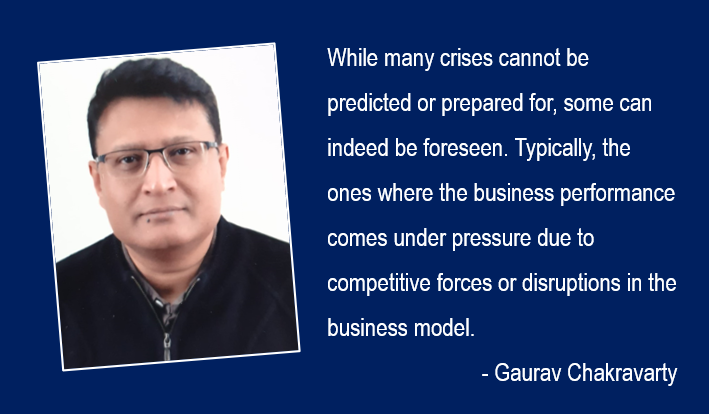A crisis is a situation that one can never really plan for, let alone plan perfectly. The repercussions of a crisis can be both short term and long term and the crisis can hamper relations with customers, suppliers, employees, media, public, government, shareholders and malign public opinion. The leadership teams are the worst affected, many times gripped with dilemma of not knowing whether to act or do nothing.
A crisis can come in many forms such as product issues or recalls, labour issues, criminal cases, environmental damages or even loss of business with collapse of business models/disruptions. While many crises cannot be predicted or prepared for, some can indeed be foreseen. Typically, the ones where the business performance comes under pressure due to competitive forces or disruptions in the business model.
The airlines industry in India has seen some tumultuous times in the recent past. With the folding up of Kingfisher Airlines, it set the trend for more airlines to be mired in trouble. Two distinct examples are worth examining.
Firstly, Jet Airways. In a sense, Jet Airways epitomised success for the private aviation industry. One of the earliest operators which went from being an Air Taxi Operator to a full-fledged private airline over the years, worthy of being compared with the best in class. It transformed itself during the changing times of the 90s, where other operators such as East-West, Modiluft and Damania folded up. Unfortunately, it could not manage to deal with disruptions and volatility in the Low-Cost vs Full-service regime.
Secondly, SpiceJet. It came back from the brink. The original founder of the airline came back to take control of a sinking business and resurrected it to become one of the smartest operators in the sky. While the management team went about fixing operations issues, they continuously kept their key stake holders informed. At the right time, they mounted a strategic campaign with consumers to ensure an adequate perception building exercise was undertaken to project the imagery of the company in the right way.
In the same way, did Jet Airways have an opportunity to get support from its key stakeholders like customers, partners, suppliers during its most critical times? Is it not true that Jet always had massive equity amongst its most loyal customers – the professionals who wanted to fly with a superior service expectation. Also, what about the gap that had been left vacant with the exit of Kingfisher? Could Jet not have mounted a strategic campaign from all its loyalists (the powerful Jet Privilege program) and sympathizers and mounted pressure on the ministry to help a possible bail-out? After all, SpiceJet managed to do that even when it hardly had a loyalty base.
Its highly possible that through a strategic approach, a crisis can be converted into an opportunity. If handled with sensitivity, care and compassion, a belligerent audience can also be convinced and they could eventually become strong advocates.
To create a strategic framework of all stakeholders, the following are recommended:
- Programme Team: An expert team whose focus is to establish a broad coalition of support. This would likely include specialists in media, digital and social, and stakeholder engagement.
- Media: The traditional media is an effective, intrusive medium through which to communicate the message. One needs to work to ensure reach with the right journalists, in the right medium, at the right time, with the right message.
- Digital and Social Media: This channel is important for reinforcing and articulating the message. This is needed to communicate the message directly to those people being sought to motivate and influence, including determining key digital influencers; identify the most relevant local audience and relevant digital mechanism so as to effectively communicate with them and ensure online content reinforces the core messaging.
Through digital analysis, its important to determine the size, scope and sentiment of existing conversations and how they relate to the objectives and the people relevant to the operations. This process can be amplified and expedited through creative content and paid digital advertising that drives traffic. - Stakeholder engagement: Influential third-party individuals and groups carry significant credibility amongst business leaders, investors, media and key decision makers as neutral arbiter of information. Its important to identify those third parties who are natural friends and allies of the aggrieved party and who would have an interest in the issue and would be willing to actively advocate the cause and establish a programme for such groups including through newspaper articles or speaking opportunities.
- Political engagement in key jurisdictions: Politicians are capable of either helping or hindering the arguments. To ensure the aggrieved party’s arguments receive a favourable political response, assistance is required with a targeted but low key and discreet political engagement strategy, including identifying those politicians and influencers who would be receptive and supportive of the cause
The views and opinions published here belong to the author and do not necessarily reflect the views and opinions of the publisher.



Be the first to comment on "Crisis communications & reputation management – A strategic approach to find opportunity in crisis"